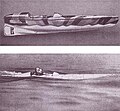
| |
| Class overview | |
|---|---|
| Name | Motorised Submersible Canoe |
| Operators | |
| Succeeded by | Swimmer Delivery Vehicle |
| General characteristics | |
| Type | Wet sub |
| Displacement | 600 pounds (270 kg) |
| Length | 12 ft 8 in (3.86 m) |
| Beam | 2 ft 3 in (0.69 m) |
| Propulsion | One 24v electric motor (5 hp), powered by four 6v batteries |
| Speed | 4.4 knots (8.1 km/h) maximum, 3.5 knots (6.5 km/h) cruise |
| Range | 40 nautical miles (74 km) |
| Test depth | 50 ft (15 m) |
| Crew | Single occupancy |
| Armament | Nine limpet mines, 3.5 pounds (1.6 kg) of explosives |
The Motorised Submersible Canoe (MSC), nicknamed Sleeping Beauty, was an underwater vehicle built by the British Special Operations Executive (SOE) during the Second World War. It was designed to enable a single frogman to sabotage enemy ships, though it would also be used for short-range reconnaissance. They were replaced by the diver propulsion vehicle after the end of the war.
Design
[edit]History
[edit]MSCs were initially conceived of in an attempt to create an improved version of the simplistic folboat.[1] It was created by the Allied Inter-Services Research Bureau[2] and designed by Major Hugh Reeves, R.E.,[3] who was also given the task of designing an 'unspecified device' for an underwater approach[citation needed] at the confidential research area Station IX. based on an idea from Lt Col "Blondie" Hasler[4] which he called the 'underwater glider' and developed at Aston House to Hasler's specifications.[5] The design process began in 1942[3] and had all but finished by the end of 1943.[6]
It was originally called the "Underwater Glider", but nicknamed the "Sleeping Beauty" before finally being officially named the Motorised Submersible Canoe.[2] According to one story, the craft became known as "Sleeping Beauty" after Reeves was discovered sleeping in it by a passing officer.[7]
Although originally commissioned for naval battles, Reeves believed that the craft could be sold to civilians to use for pearl-diving and salvage diving.[8]
Specifications
[edit]
Built from mild steel, the canoe was 12 feet 8 inches (3.86 m) long with a beam of 27 inches (0.69 m). A 5 hp electric motor powered by four 6-volt batteries gave the craft a maximum possible speed of 4.4 knots (8.1 km/h). At a crusing speed of 3.1 knots (5.7 km/h), it could travel 30 to 40 nautical miles (56 to 74 km). Its maximum operating depth was 50 feet (15 m).[9]
The Sleeping Beauty was designed to carry up to 3.5 pounds (1.6 kg) of explosives.[10] Located near the pilot's legs were ballast tanks that could either be filled with water or compressed air.[11]
Although the Sleeping Beauty was designed to accommodate only one pilot, a later model did attempt to produce a two-man version post war.[9] [page needed]
Operation
[edit]The MSC moved in several different manners. One of these was nicknamed "porpoising". When "porpoising", the pilot would allow the craft to briefly rise to the surface, re-orientate themselves, then fully re-enter the water in order to move.[1][11] Alternatively, the pilot would submerge the craft and, guided only by a compass, travel completely underwater.[12] Movement was controlled by means of a joystick attached the two ballast tanks.[11] Upon nearing a target, the pilot would exit the craft and swim the rest of the way.[1] They would then attach one of the nine magnetic limpet mines to the side of the enemy ship.[11][13] The MSC could also be used for reconnaissance, although its main purpose was for sabotage and attacks.[13][1]
Operational service
[edit]Following Operation Jaywick, a successful 1943 Allied raid in Singapore which used folboats to destroy several Japanese ships, the leader of the raid, Ivan Lyon, a British Lieutenant Colonel and member of the Z Special Unit, was brought to view and train on the Sleeping Beauties.[1] Lyon planned to use the canoes during Operation Rimau in an attempt to sabotage Japanese ships.[13] However, after being found by a Japanese patrol boat during the raid, the canoes were scuttled and Ivan Lyon and his men were killed, captured, and executed.[1] Operatives at Careening Bay continued to be trained on MSCs, but few men were ever able to use them effectively and they never entered into widespread usage.[11]
During the summer of 1944, "Sleeping Beauty Number 72" was delivered to the United States Office of Strategic Services (OSS). It was used for training until August 1945.[13]
Gallery
[edit]References
[edit]Citations
[edit]- ^ a b c d e f "The Sleeping Beauties". www.sea.museum. Archived from the original on 11 April 2021. Retrieved 1 September 2024.
- ^ a b Rees 2008, p. 3
- ^ a b Rees 2008, p. 6
- ^ Southby-Tailyour, 1998, p74
- ^ Southby-Tailyour, 1998, p126
- ^ Rees 2008, p. 263
- ^ Rees 2008, p. 248
- ^ Rees 2008, p. 247
- ^ a b Rees, 2008
- ^ "BBC - History - World Wars: British Special Operations Executive (SOE): Tools and Gadgets Gallery". www.bbc.co.uk. Retrieved 31 October 2024.
- ^ a b c d e "Motorised Submersible Canoe "Sleeping Beauty"". www.collectionswa.net.au. Retrieved 1 September 2024.
- ^ Thompson, Peter A.; Macklin, Robert (2007). Kill the tiger : Operation Rimau and the battle for Southeast Asia. Maverick House. p. 12. ISBN 978-1-905379-39-2.
- ^ a b c d "News Archive 25". www.mcdoa.org.uk. Retrieved 31 October 2024.
Bibliography
[edit]- Ross, Anderson (2010), Report on background and maritime archaeological survey for a Motorised Submersible Canoe (MSC) or 'Sleeping Beauty' lost 1945, HMAS Stirling, Careening Bay, Cockburn Sound (PDF), Western Australian Museum, archived from the original on 14 April 2014
- "Britain reveals diving canoe", Popular Science, vol. 150, no. 3, March 1947, ISSN 0161-7370
- Rees, Quentin (2008). Cockleshell Canoes: British Military Canoes of World War Two. Most Secret. Amberley Publishing. ISBN 978-1-84868-065-4..
- Southby-Tailyour, Ewen (1998), Blondie, Leo Cooper, ISBN 9780850525168


